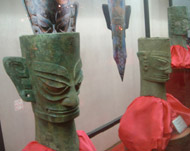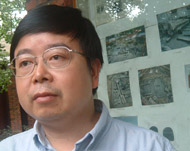Ancient ruins rewriting China history
The Shu Dynasty (1122 BCE to 221 BCE) of China, were they worshippers of an all powerful sun god, a Southeast Asian tribe that took a wrong turn, or perhaps a civilisation inspired by aliens?

The mysteries surrounding China’s most famous burial site have yet to be fully solved but archaeologists shifting through the evidence have already gathered enough to begin rewriting the nation’s history books.
Unearthed in 2001 by a development company digging in the Chengdu suburbs, Jinsha is currently not much to look at.
A series of holes in the ground surrounded by scrubland, the only indication of its value is the skeleton of a hanger-shaped museum being erected over the top of it.
When finished, however, it is hoped the onsite museum will rival the famed Terracotta Warriors, which guard the tomb of the first Qin emperor Qin Shihuang.
Fascinating finds
Possibly dating back as far as 3500 BCE, to the late Neolithic age, the site has yielded some fascinating finds.
Exquisitely designed bronze sacrificial vessels of a calibre exceeding contemporaries in the ancient Middle East, pieces of polished jade fashioned into axe heads, and most curiously, stretched stone faces carved with Spock-like pointy ears and ornate headdresses.
 |
|
Do these Spock-like pointy eared |
Unlike anything seen before, these faces have come to symbolise the archaeological excavations in this area, both here at Jinsha and in nearby Sanxingdui, 40km north of Chengdu in the town of Guanghan.
More poignantly, it is what these sites represent as centres of ancient civilisation that excites historians.
Popular history has always believed that Chinese civilisation originated in the Yellow River area with the Xia and Shang Dynasties.
It was from these dynasties that the first examples of the Chinese script were found, as well as the beginnings of a hereditary leadership system distinct from an earlier practice of chieftain elections.
Multiple origins
The digs in Sichuan however, have confirmed what many archaeologists already suspected, that Chinese civilisation has multiple origins.
“Originally we only knew about the ancient Shu culture from tales in the later Qin and Han Dynasties,” explained Jiang Zhanghua from the Chengdu Institute of Archaeology, referring to a legendary dynasty that is now believed to have had its capital at Sanxingdui.
“From the stories we never knew anything substantial. These stories simply mentioned certain kings and their personal traits. Now we understand their history and know that the stories are true.”
Roughly corresponding to present day Sichuan, the Shu Dynasty was governed from a capital both physically impressive and materially wealthy.
 |
|
Chengdu Archaeology Institute’s |
Encircled by a 12-km clay wall, indications are that Sanxingdui was a bustling centre of trade.
Cowry shells from the south China coastline, elephant tusks from Southeast Asia, and minerals alien to Sichuan, such as copper, tin and lead (used in bronze making), all suggest a sophisticated barter or possibly even currency system was in operation.
The presence of clay tripods used as wine vessels, and decorative clothing carved on the unearthed statues, suggest a predilection for the good life.
Trading hub
What is unclear is how the ancient Shu discovered how to fire clay and mould bronze to such sophisticated levels.
Some believe they were in regular trading contact with tribes along the Yellow River, while others postulate a central Asian influence. What is accepted is that the area was a centre of culture and civilisation in its own right.
Society was structured and class level was instantly recognisable by clothing and hairstyle – long queue (single braided tail) for workers, tied bun for the elite.
Believed to have been monotheistic in their worship of a sun god, excavations at Sanxingdui and Jinsha have revealed a world rich in religious symbolism and ritual.
The most spectacular of these is a giant golden tree standing almost 4-m high with dog headed serpents snaking their way up its trunk.
On each branch sits a giant bird, which legend has it, carried the sun on its back across the sky.
Tree worship was also a common trait of tribes in Mesopotamia – modern day Iraq – but experts remain cautious about suggesting that one culture influenced the other.
At Sanxingdui, a site that predates Jinsha, jade and golden ornaments are believed to have represented offerings, and the discovery of turtle shells a predilection for divination.
It is hypothesised that the city’s ruler was responsible for both spiritual and temporary affairs but without any written records researchers are often left to fill in the blanks with guesswork.
Alien theory
It is also the lack of written evidence that has given rise to some of the more bizarre theories circling the internet on the origins of these cultures.
First discovered in 1929 by farmers digging a drainage ditch, Sanxingdui has been rumoured to be the offshoot of an extraterrestrial civilisation.
|
“Sanxingdui culture ended due to conflict with outside forces. The idea of a flood is not feasible because at that time the geography of the area would not have made it possible. And if there were a disease then there would be more bodies” Sun Hua, professor of archaeology at Peking University |
Presumably inspired by the Star Trek style face carvings, the alien theory is given an additional twist by the mysterious abandonment of the city around the year 3000 BCE.
While some suspect a disease or flood wiped out the city, Sun Hua of Peking University has his own theory.
“Sanxingdui culture ended due to conflict with outside forces. The idea of a flood is not feasible because at that time the geography of the area would not have made it possible.
“And if there were a disease then there would be more bodies,” says the professor of archaeology at Peking University.
Rise and fall
In explaining what happened to the citizens of Sanxingdui, the discovery of Jinsha a decade ago offers new clues says Jiang.
Spending over 20 years investigating the two sites from his single storey corrugated-roofed Chengdu office, Jiang’s whodunit is that Jinsha is an amalgamation of Sanxingdui refugees and tribes from further down the Yangtze.
Holding open a book detailing the shapes of prehistoric wine amphora, Jiang says that the combination of both round bottom vessels favoured in Sanxingdui and flat bottomed containers from what is now Hubei indicate a blending of the two Yangtze river cultures.
His theory also helps explain why at the time of Sanxingdui’s sudden demise, the population of Jinsha appears to have risen suddenly.
As for the masks, with their bulging eyes and otherworldly ears, nobody can offer a satisfactory explanation.
“Maybe Europe, maybe central Asia,” we don’t know, says Jiang. Could they have come from a distant galaxy? “Unlikely,” he says.